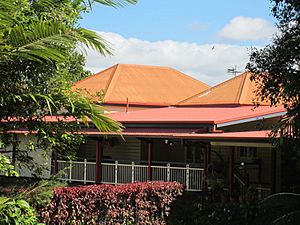Williams' House, Yungaburra facts for kids
Quick facts for kids Williams' House |
|
|---|---|

Williams' House, 2015
|
|
| Location | 16-20 Cedar Street, Yungaburra, Tablelands Region, Queensland, Australia |
| Design period | 1900 - 1914 (early 20th century) |
| Built | c. 1915 - 1940s |
| Official name: Residence 16-20 Cedar Street, Williams' House | |
| Type | state heritage (built) |
| Designated | 21 October 1992 |
| Reference no. | 600472 |
| Significant period | 1910s-1940s (fabric, historical) |
| Significant components | residential accommodation - main house, kitchen/kitchen house |
| Lua error in Module:Location_map at line 420: attempt to index field 'wikibase' (a nil value). | |
The Williams' House is a special old home in Yungaburra, Queensland, Australia. It is listed on the Queensland Heritage Register, which means it's an important building from the past that needs to be protected. The house was built in stages, starting around 1915 and continuing into the 1940s. It is located at 16-20 Cedar Street.
Contents
A Look Back: Yungaburra's Early Days
Yungaburra began as a small settlement called Allumbah in 1888. It was part of a plan to help people get land for farming and homes. Farmers could get land, and their houses would be grouped together in a village.
Around this time, a railway line was being built from Cairns to the Atherton Tableland. This railway was very important because it made it easier to travel and move goods. Even though the railway took a long time to build, it helped the area grow.
By 1903, the railway reached nearby Atherton. This made it much easier for people to get to Allumbah. More people started to settle around the area, and a small town began to form with shops and services.
The Railway Arrives and the Town Changes
In 1910, the railway finally reached Allumbah. To avoid confusion with another town, Allumbah was renamed Yungaburra. This was a big moment for the town!
With the railway now in Yungaburra, the town grew quickly. A sawmill was built, along with a hotel, shops, and more houses. The new railway station changed where the town's center was. Many buildings were either built new or moved closer to the station.
The land where Williams' House stands was originally part of a large farm. It was later divided into smaller blocks after the railway opened.
The Williams Family and Their Businesses
In 1915, the Williams family bought the property where the house is. The family business, "Estate H.S. Williams," was named after their father, Henry S. Williams. Henry had started various businesses in the area, including a store and a butchery.
The Williams family was very important to Yungaburra. They owned many businesses, including a hotel, a store, a butchery, and a bakery. They even started a touring car company called "Cairns and Tableland Motor Services Limited," which was known for its "White Cars." This company brought tourists from Cairns to see the beautiful Tablelands.
The Williams family's hotel became a popular place for tourists and events. The house itself is believed to have been first lived in by Edward Stratten (Ned) Williams, one of Henry's sons. As his family grew, more rooms were added to the house.
Growth and Changes During Wartime
In 1926, the Gillies Highway opened. This new road made it even easier for tourists to visit Yungaburra and the nearby lakes. This led to another period of growth for the town.
After Ned Williams passed away, his brother Frederick moved into the house. He raised his own five children and Ned's four children there. More rooms were added to the house to fit the large family.
During World War II, many soldiers came to the Tablelands for training and rest. The Williams family's hotel was a popular spot for soldiers to relax and enjoy dances and music. A deck was even added to the house so people could dance!
The Williams family worked together and had many different businesses. They provided a lot of jobs in the area and helped Yungaburra grow and develop. The family owned the house until 1976. It was later divided into two separate homes.
What Williams' House Looks Like
Williams' House is a single-story timber building. It stands on stumps, which means it's raised off the ground. The roof is made of corrugated iron and has a mix of hip and gable shapes.
At the front of the house, what used to be a porch (verandah) has been closed in with timber and windows. There are also sliding windows with pink and green glass on the sides of the building.
At the back, there might have been a separate kitchen building long ago, but it's now part of the main house. Over the years, parts of the house have been changed. For example, a section of the verandah was removed on one side. On the other side, there's a deck with a roof over it.
Inside, the walls are made of vertical timber boards. The floors and ceilings are also timber. Some walls have been added or removed over time, especially when the house was split into two homes.
In front of the property, there's a wall about 1 meter (3 feet) high made of large basalt rocks.
Why Williams' House is Important
Williams' House was listed on the Queensland Heritage Register in 1992 for a few reasons:
- It shows how Queensland's history unfolded: The house was built when Yungaburra was growing rapidly, especially after the railway arrived. It helps us understand how the town developed.
- It has a special look: As a timber house built in a traditional style, it adds to the unique character of Yungaburra.
- It's connected to important people: The house has a long history with the Williams family. This family played a huge role in building up the businesses and community in Yungaburra.

